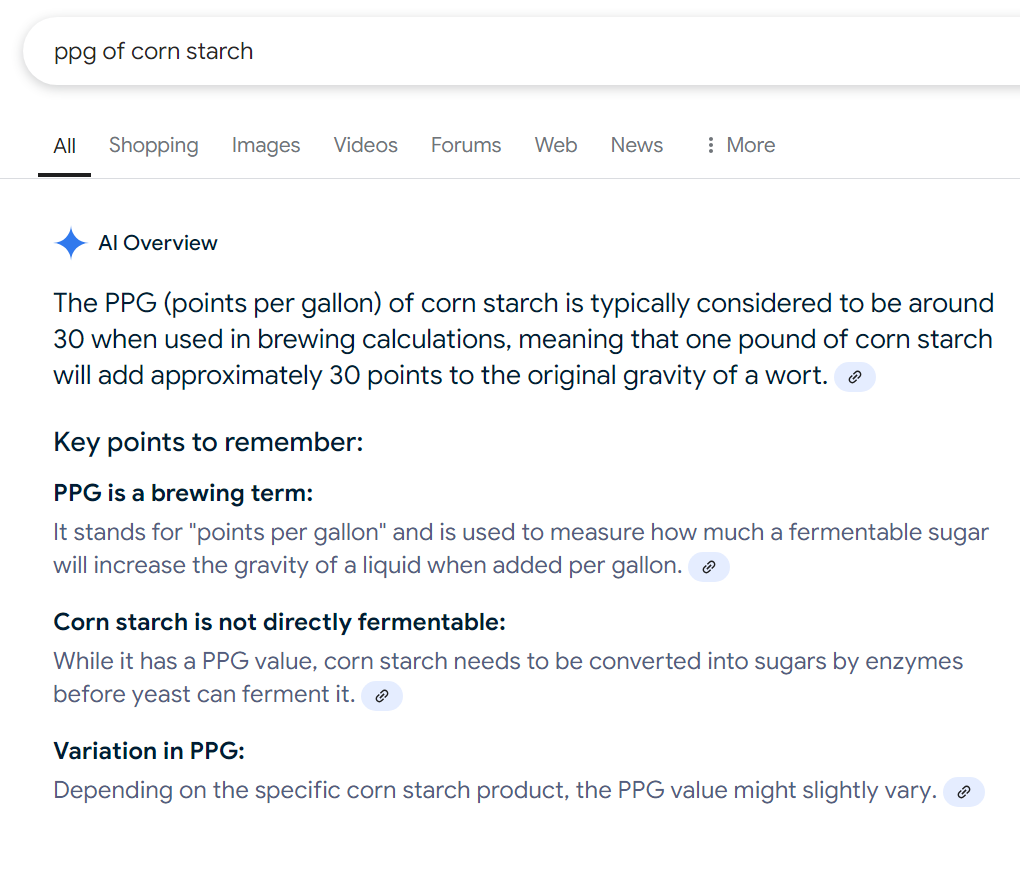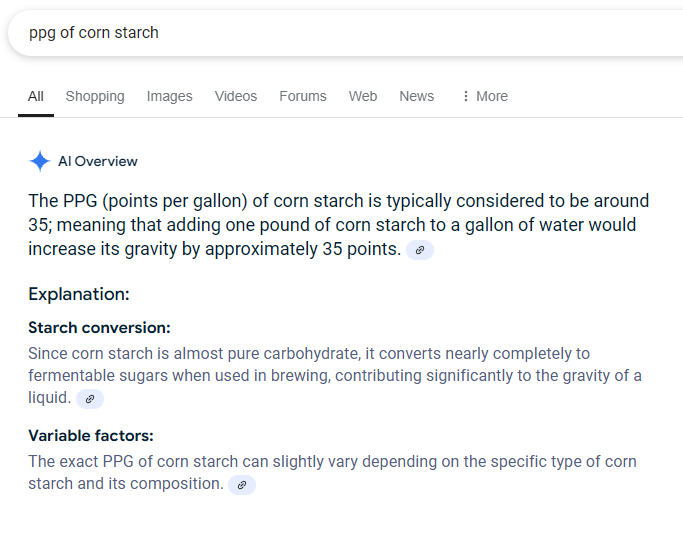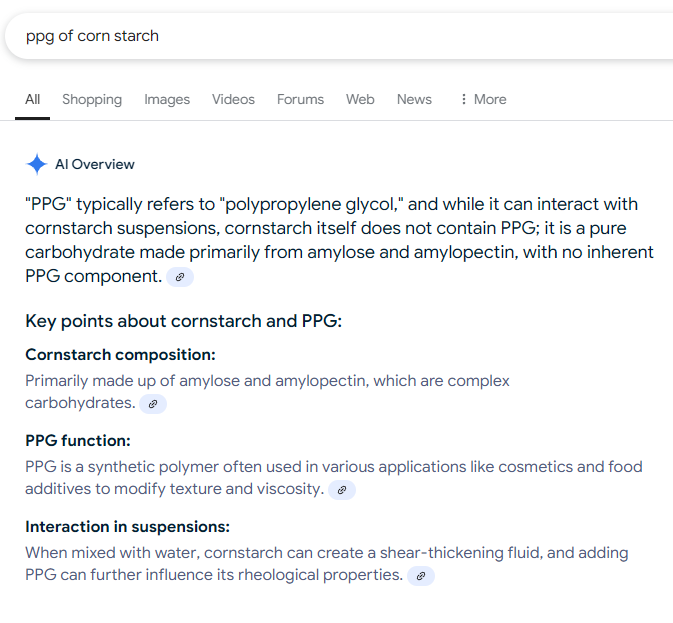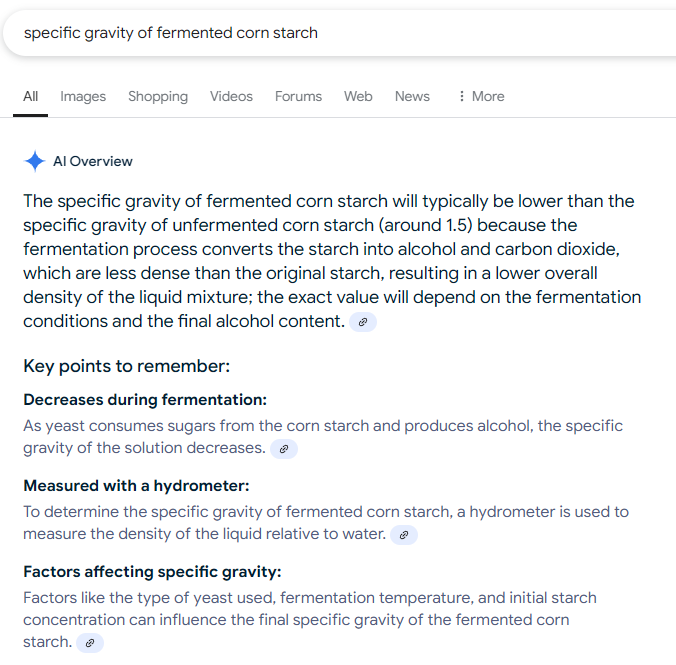You are using an out of date browser. It may not display this or other websites correctly.
You should upgrade or use an alternative browser.
You should upgrade or use an alternative browser.
Corn starch
- Thread starter Nooor
- Start date

Help Support Homebrew Talk:
This site may earn a commission from merchant affiliate
links, including eBay, Amazon, and others.
AdjunctBrewer
Well-Known Member
It's about the same potential as flaked corn but it depends on the conversion rate. Using products like glucoamylases might get you 100% conversion as opposed to mashing with barley, wheat, etc... where the Lintner power of the mash, mash time, mash make-up, etc... would affect the final conversion rate.
Approximately:
1 lb of sugar in 1 gallon of water gives 1.045 SG max
1 lb of flaked corn in 1 gallon of water gives 1.037 - 1.039 SG max (80-85% FG basis) with a typical 75% mash efficiency yields ~1.029 SG
Approximately:
1 lb of sugar in 1 gallon of water gives 1.045 SG max
1 lb of flaked corn in 1 gallon of water gives 1.037 - 1.039 SG max (80-85% FG basis) with a typical 75% mash efficiency yields ~1.029 SG
This isn't quite correct. If you mix 1 lb of table sugar (sucrose) with 1 gal of water (8.33 lb @ 68°F/20°C), then we end up with a solution at: 100°P * 1.00 lb / (1.00 lb + 8.33 lb) = 10.72°P. Looking up 10.72°P in the sugar tables gives the SG as 1.043. The volume is then 9.33 lb / (8.33 lb/gal * 1.043) = 1.074 gal.It's about the same potential as flaked corn but it depends on the conversion rate. Using products like glucoamylases might get you 100% conversion as opposed to mashing with barley, wheat, etc... where the Lintner power of the mash, mash time, mash make-up, etc... would affect the final conversion rate.
Approximately:
1 lb of sugar in 1 gallon of water gives 1.045 SG max
1 lb of flaked corn in 1 gallon of water gives 1.037 - 1.039 SG max (80-85% FG basis) with a typical 75% mash efficiency yields ~1.029 SG
The listed potential for sucrose is 1.0462. But this is defined for 1 lb of sucrose in 1 gal of solution (not added to 1 gal of water.) To get 1 gal of solution with 1 lb of sucrose, you only need to add 0.926 gal of water, since the sucrose contributes some of the total volume of 1 gal. In this case the °P works out to: 100°P * 1.00 lb / (1.00 lb + 0.926 gal * 8.33 lb/gal) = 11.48°P. Looking up 11.48 in the sugar table gives the SG as 1.0462, which matches the potential of sucrose.
Doing a cursory search for data on corn starch indicates that it is about 96% carbohydrates (28g of carbs in 29g of starch), which should all go into solution if mashed. That would put the SG potential at 1 + 0.96 * 46.2/1000 = 1.044, which is significantly higher than 1.037 - 1.039.
Cornstarch is also about 25 - 30% amylose, and the balance amylopectin, so there is potentially a lot of limit dextrin that could result from mashing if only using alpha amylase. This isn't necessarily a problem if you are using cornstarch as an adjunct in beer, but if you are making a wash for distilling, you might want to consider adding amyloglucosidase (gluco amylase) to convert the limit dextrin into fermentable sugar.
Brew on

AdjunctBrewer
Well-Known Member
You're not wrong but unless the corn starch is completely converted with amyloglucosidase it probably doesn't reach that potential.
IIRC Asahi Super Dry uses corn starch.

IIRC Asahi Super Dry uses corn starch.

You get the SG contribution as soon as the starch is cut into pieces small enough to be soluble. This doesn't mean that everything in solution is fermentable. This is why I mentioned amyloglucosidase as needed if you want to convert the limit dextrin (that can't by hydrolyzed by alpha or beta amylase) into fermentable sugar.You're not wrong but unless the corn starch is completely converted with amyloglucosidase it probably doesn't reach that potential.
IIRC Asahi Super Dry uses corn starch.
View attachment 865279
Also, I'm not ready to take an AI generated answer at face value. This is why I went looking for information on the actual composition of cornstarch.
Brew on


$7.79 ($7.79 / Count)
Craft A Brew - LalBrew Voss™ - Kveik Ale Yeast - For Craft Lagers - Ingredients for Home Brewing - Beer Making Supplies - (1 Pack)
Craft a Brew

$176.97
1pc Commercial Keg Manifold 2" Tri Clamp,Ball Lock Tapping Head,Pressure Gauge/Adjustable PRV for Kegging,Fermentation Control
hanhanbaihuoxiaoshoudian

$719.00
$799.00
EdgeStar KC2000TWIN Full Size Dual Tap Kegerator & Draft Beer Dispenser - Black
Amazon.com

$33.99 ($17.00 / Count)
$41.99 ($21.00 / Count)
2 Pack 1 Gallon Large Fermentation Jars with 3 Airlocks and 2 SCREW Lids(100% Airtight Heavy Duty Lid w Silicone) - Wide Mouth Glass Jars w Scale Mark - Pickle Jars for Sauerkraut, Sourdough Starter
Qianfenie Direct

$53.24
1pc Hose Barb/MFL 1.5" Tri Clamp to Ball Lock Post Liquid Gas Homebrew Kegging Fermentation Parts Brewer Hardware SUS304(Liquid Hose Barb)
yunchengshiyanhuqucuichendianzishangwuyouxiangongsi

$53.24
1pc Hose Barb/MFL 1.5" Tri Clamp to Ball Lock Post Liquid Gas Homebrew Kegging Fermentation Parts Brewer Hardware SUS304(Liquid Hose Barb)
Guangshui Weilu You Trading Co., Ltd

$159.50 ($26.58 / Count)
3M High Flow Series System BREW120-MS, 5616001, For Brewed Coffee and Hot Tea, Valve-in-Head Design
Amazon.com

$22.00 ($623.23 / Ounce)
AMZLMPKNTW Ball Lock Sample Faucet 30cm Reinforced Silicone Hose Secondary Fermentation Homebrew Kegging joyful
无为中南商贸有限公司

$10.99 ($31.16 / Ounce)
Hornindal Kveik Yeast for Homebrewing - Mead, Cider, Wine, Beer - 10g Packet - Saccharomyces Cerevisiae - Sold by Shadowhive.com
Shadowhive

$20.94
$29.99
The Brew Your Own Big Book of Clone Recipes: Featuring 300 Homebrew Recipes from Your Favorite Breweries
Amazon.com

$44.99
$49.95
Craft A Brew - Mead Making Kit – Reusable Make Your Own Mead Kit – Yields 1 Gallon of Mead
Craft a Brew

$58.16
HUIZHUGS Brewing Equipment Keg Ball Lock Faucet 30cm Reinforced Silicone Hose Secondary Fermentation Homebrew Kegging Brewing Equipment
xiangshuizhenzhanglingfengshop
AdjunctBrewer
Well-Known Member
The AI... it's alive!


I have done two batches of beer using corn starch. In Beersmith I replace/substituted the amount of corn starch with corn sugar and changed the mash body profile to high to compensate for the fact it was not really sugar. I mash at 152 for medium body and estimates of starting and final gravity where pretty close in the final beer.
I think modeling the corn starch as a base malt grain addition of (starch weight) * (sugar PPG)/(grain PPG) might be easier than messing with the body setting.
If you buy grain in bulk the cost of most adjuncts are more than base malt but store brand corn starch at big box store gets close.
I think modeling the corn starch as a base malt grain addition of (starch weight) * (sugar PPG)/(grain PPG) might be easier than messing with the body setting.
If you buy grain in bulk the cost of most adjuncts are more than base malt but store brand corn starch at big box store gets close.
You're not wrong but unless the corn starch is completely converted with amyloglucosidase it probably doesn't reach that potential.
IIRC Asahi Super Dry uses corn starch.
View attachment 865279
Ask it twice and get two different answers
Also, in the second ask, the AI makes the common error in the definition of PPG (water volume vs. wort volume, see post #4 above.). In the first ask the PPG definition is just incomplete.
My faith in AI continues to build ... NOT.
Brew on

AdjunctBrewer
Well-Known Member
Be careful, you shouldn't poke fun at the AI...


AdjunctBrewer
Well-Known Member
It seems the AI is learning... and is getting closer to a conclusion... but a different query.


What's the chance that Asahi is using CORN SYRUP, but not American corn syrup AKA Korean corn syrup and is chemically altered cornstarch and is pretty much just glucose syrup? <ed. and has NO VANILLA and is brilliantly clear>
Glucose too early in the fermentation could lead to increased esters which is not normally wanted in lagers.
Glucose too early in the fermentation could lead to increased esters which is not normally wanted in lagers.
Noted! So when would they add it? After full kraeusen is underway? Or do the big breweries add it to an actual secondary?
I would guess they dont use sugar for lagers, the use of unprocessed grain or starch seems like it would be cheaper.
I googled brown rice syrup and it says it is created with barley so it is maltose and low in glucose, that seem like it work well for making beer.
I googled brown rice syrup and it says it is created with barley so it is maltose and low in glucose, that seem like it work well for making beer.
I would guess they dont use sugar for lagers, the use of unprocessed grain or starch seems like it would be cheaper.
I googled brown rice syrup and it says it is created with barley so it is maltose and low in glucose, that seem like it work well for making beer.
Industrially produced sugar syrups tend to use exogenous (added, non-naturally occurring) enzymes to maximize the creation of the desired sugar profile, rather than depending on just the naturally occurring enzymes in malt. Exogenous enzymes also allow the producer to skip the malting process, for a shorter, cheaper process.
The starch source has little to do with the final ratios of glucose to maltose to maltotriose (the primary fermentable sugars) in the wort. It is more dependent on the activity ratio of beta amylase to alpha amylase (and any other enzymes that hydrolyze the 1-4 glucosidic bonds in starch that may be present.) Beta amylase creates only maltose from starch, so high beta activity favors more maltose relative to the other fermentable sugars. Alpha amylase creates all three ferrmentable sugars, as well as larger, non-fermentable poly-saccharides.
Now, if you only use the naturally occurring (endogenous) enzymes in the malt of whatever grain you get the starch from, in that case starch from barley may by higher in maltose, if barley malt has higher beta amylase activity than malt from other grains. We talk a lot on HBT about the enzymes in barley malt, but very little about the enzymes in other malts, and I don't know whether barley has more beta activity or not.
Brew on

Similar threads
- Replies
- 10
- Views
- 516























![Craft A Brew - Safale BE-256 Yeast - Fermentis - Belgian Ale Dry Yeast - For Belgian & Strong Ales - Ingredients for Home Brewing - Beer Making Supplies - [3 Pack]](https://m.media-amazon.com/images/I/51bcKEwQmWL._SL500_.jpg)





















